If you are an aquarist, you know that there is nothing more enjoyable than having a well-kept aquarium. One of the most important aspects of keeping fish in your tank is choosing the right companions for them. Plecos are one type of fish that would be a good fit for any size aquarium and can provide many benefits to your aquatic environment. In this blog post, we will go over 15 different types of plecos so that you can find one perfect for your needs!
To Start – Let’s Talk Minimum Tank Size
For very small pleco species, you will need at least a 20+ gallon aquarium as minimum tank size. If you want to keep your plecos in an aquarium smaller than 30 gallons, you will need to provide extra hiding spots. You will also need the proper filtering system to match that minimum tank size.
A 30+ gallon aquarium is the minimum tank size for most juvenile and small dwarf species of plecos.
65-gallon aquariums are good for medium-sized pleco species, such as some bristle nose pleco or many common plecostomus. Some plecostomus species, however, grow exceptionally big, requiring over 95 gallons as a minimum tank size.
90+ gallon aquariums are generally considered appropriate for most adult-sized plecos. Some very large plecos can reach up to a maximum size of 24 inches long.
Common Pleco
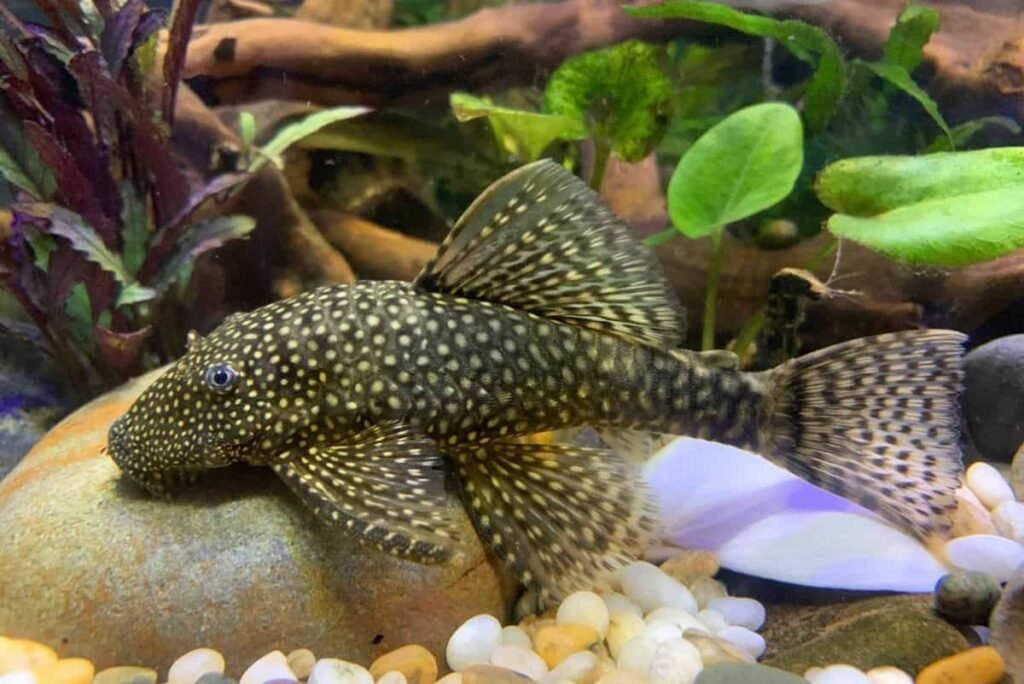
Hypostomus plecostomus, or the common pleco, is one of the popular types of plecos (probably the most common pleco species in the world). Keep in mind that this is a very large species of plecos, growing up to 24 inches long. This is not a good type of plecos for an aquarium with less than 65 gallons of water. This type of pleco really needs its own space!
Zebra Pleco

These are striped types of plecos that mimic the shape of a zebra (hence the name Zebra Plecos). They grow to around 4 inches. Care is fairly easy. Keep their tank in a tropical heated aquarium with non-aggressive partners. They live between 10 and 15 years, depending on the level of care. They are carnivorous plecos with a low degree of herbivory, requiring lie food and feed for carnivores to maintain good health. These species are shy at first during the day and often want comfortable hiding places to rest. After some time, they tend to become less shy and explore the whole aquarium. They look wonderful in groups and are easy to reproduce.
Sailfin Pleco

Sailfin plecos are grown to a maximum height of around 14 inches and can live for 20 years. They are pretty fish with a leopard-print pattern covering their body armor. They eat mostly plant food and sometimes largely animal protein. You must make sure that you provide a tank suitable for their size. Because they are big and feed all day, they both keep the tank free of algae and produce huge amounts of excrement.
Leopard Frog Pleco
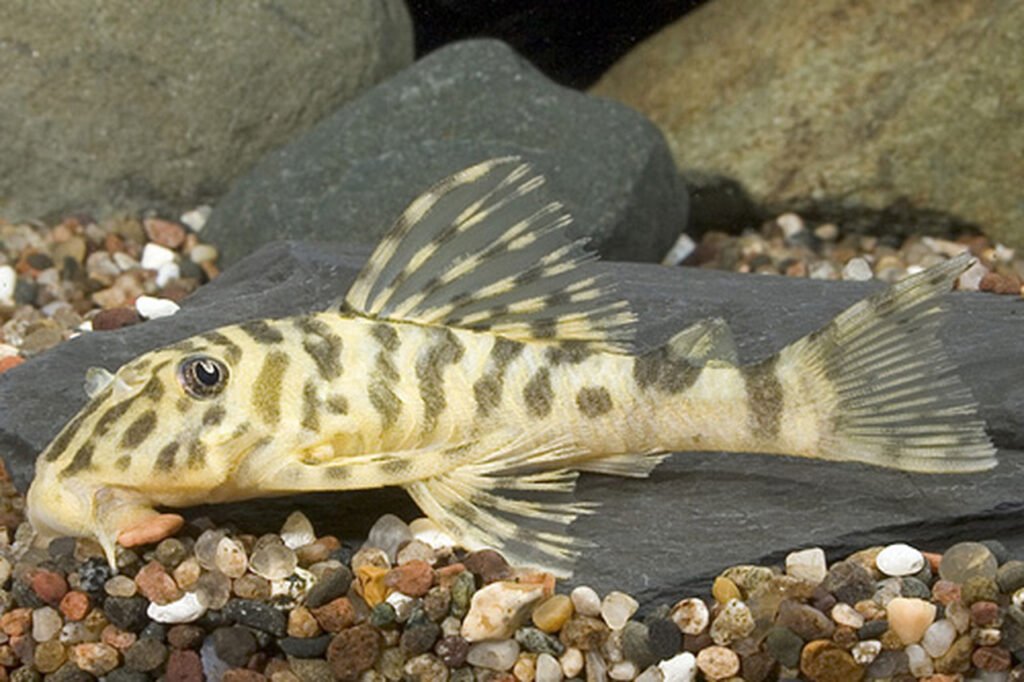
Leopard frog plecos usually age 8 to 10 years. Their average length is just slightly more than 4 inches. They are omnivores with a strong herbivorous tendency, and they prefer other plant materials to algae. Thus, while great additions to the tank, they do not act as good tank cleaners.
Snowball Pleco
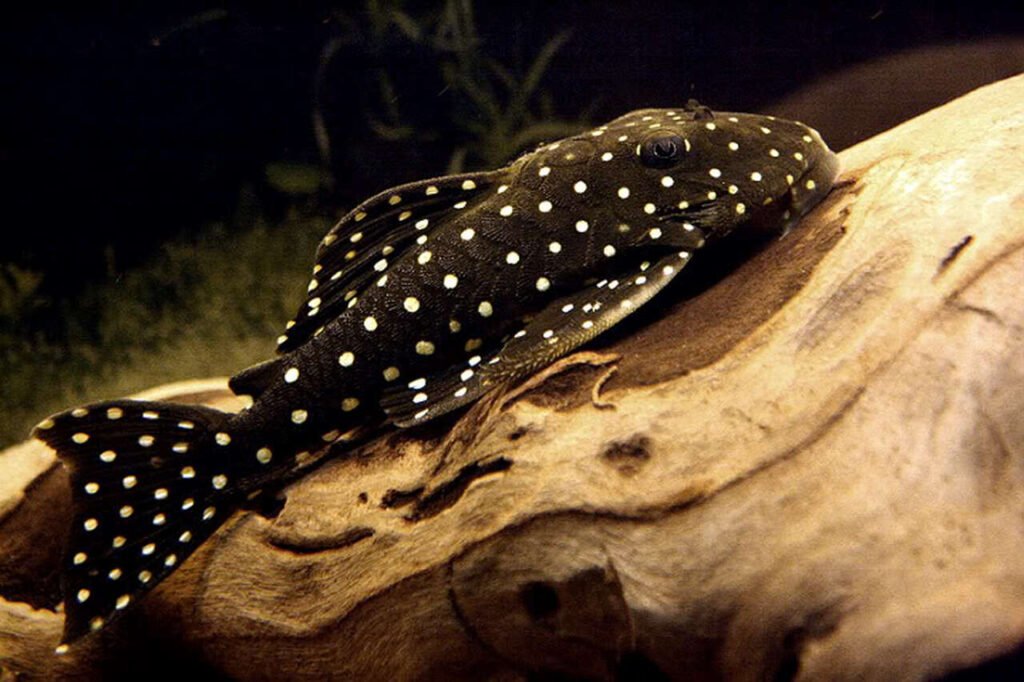
There are three species commonly called Snowball pleco. Together, these three species range in size from 5 to 12 inches (the two from the genus baryancistrus are larger than the other, from the genus hypancistrus)… They derive their name from the patterns of white dots that they have. Depending on water and food quality and general care, these species live about 8 to 10 years. Depending on the species, Snowball plecos may be hungry for biofilm and plant foods, eat algae in the aquarium (baryancistrus), or nearly strictly carnivorous (hypancistrus). For these creatures to thrive, plecos must have heated tropical tanks. They should also have a nice space with hiding places and great water and food quality, as they are sensitive species.
Peppermint Pleco
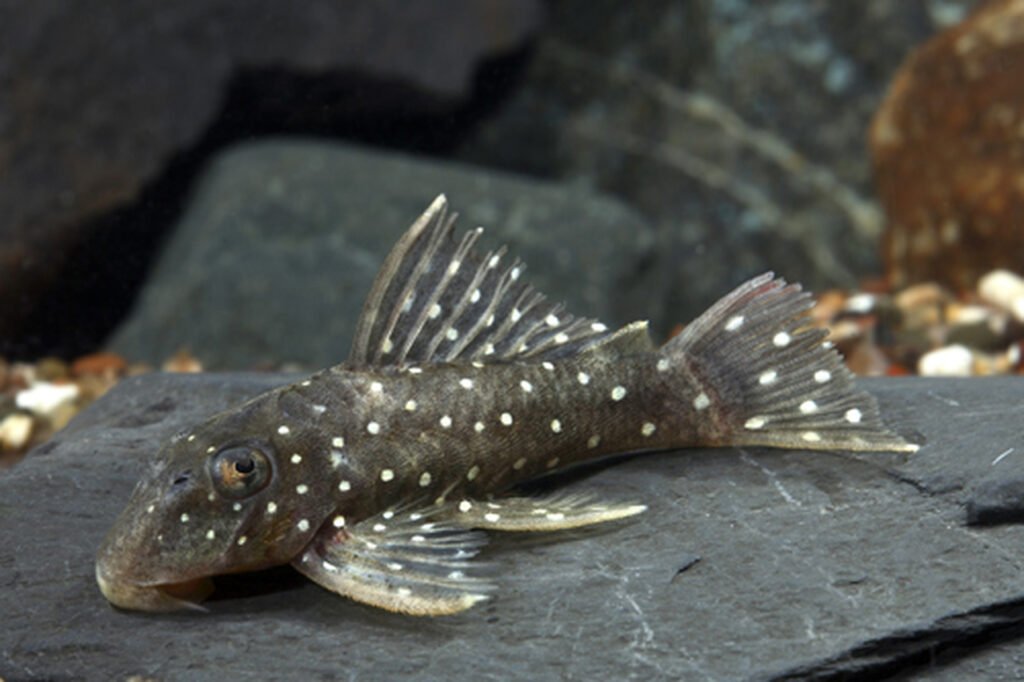
There are two species, commonly called Peppermint pleco, that grows to about 7 inches and live about 10 to 12 years. One type, from ancistrus, likes to eat vegetable matter but does not prefer algae, whereas the other, from paracistrus, eats algae ferociously. They typically are peaceful communal species with tropical tankmates. The ancistrus enjoys still waters while the parancistrus prefers fast-moving water channels. They both want warm and heated tanks.
Orange Spot Pleco
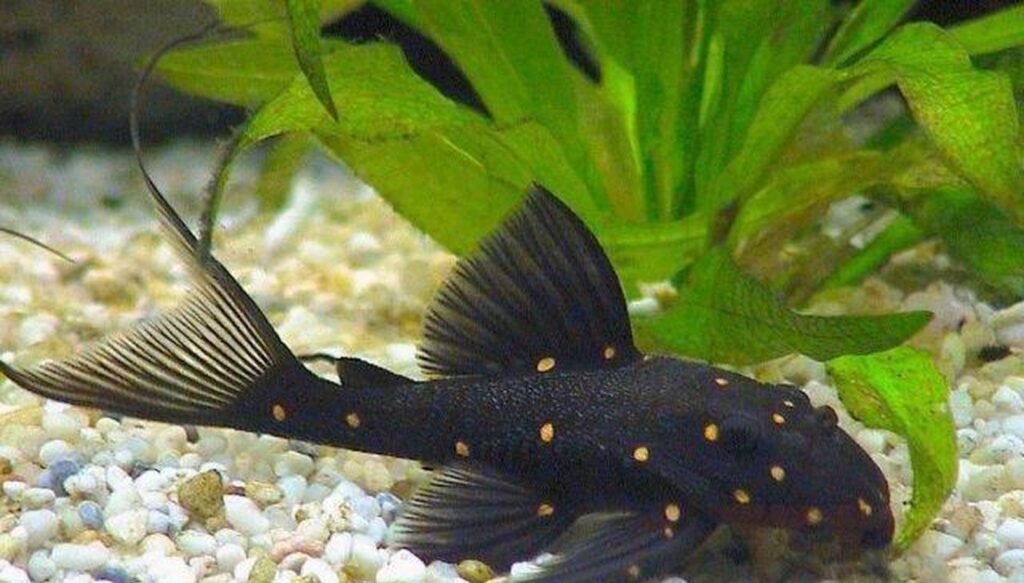
There are two species under this name, but one of them is quite rare. This section will cover the more common type, lda031.
This type of pleco loves to hide in trees and nibble on the soil. They are timid and like to go out in the total dark. They need to have driftwood in their food. They exhibit orange dots across their fins and body, making them rather interesting to look at. Unfortunately, orange spot plecos (especially males) show more aggressive behavior to other plecos, so it is good to keep them alone in a heated tank with other compatible tropical tankmates. Usually, they live at least for about 12+ years, and their maximum size is about 5 inches.
Royal Pleco

This species of pleco is known for its digestion of various woods. Their bodies and fins are irregularly colored, striped in black and white patterns. They weigh about 22 kilograms and last about 10 years on average. They predominantly eat algae-based foods like sinking pellets or wafers and occasionally enjoy meat-based snacks. Because of their large size, they can perform well in large heated tanks, and they do well with other fish.
Butterfly Pleco

Butterfly plecos are nocturnal and like to hide in the dark at times. Interestingly, these fish change colors very quickly; when on a dark substrate, they will turn nearly black, but they will show a pretty striped pattern during the day on lighter substrates. These fish have an extremely healthy appetite. They live on algae constantly and need supplementary food such as grilled and preserved veggies. They also sometimes like animal protein, like insect larvae. While they do not feed on wood, they like the biofilm that forms on wood. These fish produce tons of waste because of their high consumption, so a healthy filtration system is important.
Otocinclus Catfish
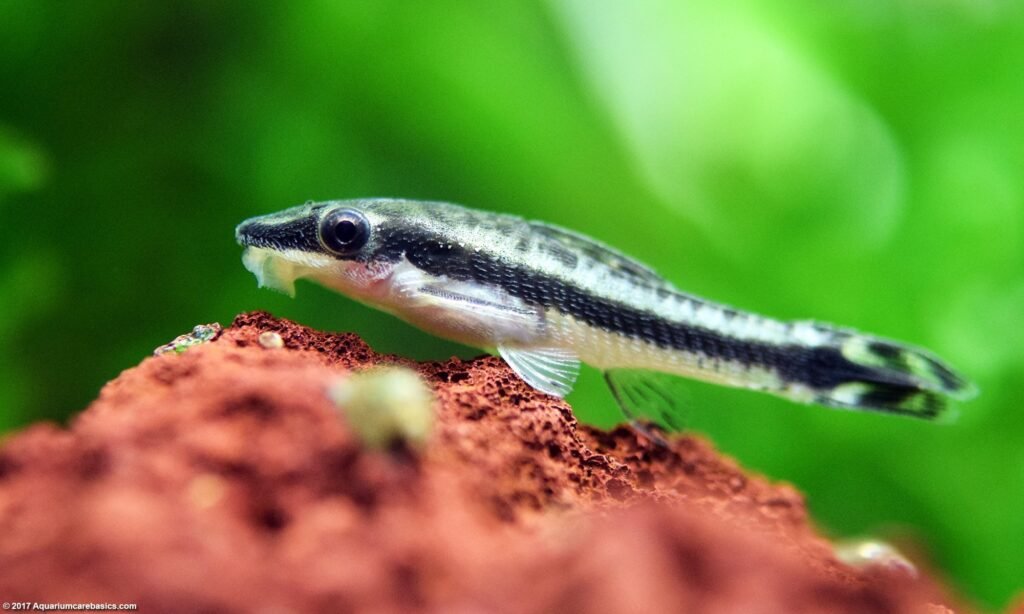
The Otocinclus catfish is an opportunist algae eater that will feed on other things when it does not have algae. It often stays on the tank walls, scraping away biofilm and algae. If you plan on buying one, you should have an existing mature tank. They are susceptible to water parameters while acclimating, so be careful. Once acclimated, they are quite resistant fish. Do some research before buying some other new tank mates for this catfish. In nature, they make giant shoals with more than 100 individuals, so it is good to keep them in shoals in aquaria. However, with large numbers of fish, the algae and biofilm reserves are quickly depleted, and not all otos will be able to convert to artificial feed. So be sure to plan before buying these fish!
Blue-Eyed Plecos

The blue-eyed pleco, native to Colombia, has amazing blue eyes. It likes driftwood to eat (they are voracious biofilm eaters), graze for algae, and hide during their inactive hours. Its body is covered in large, thick, gray armor plates. They can have a lot of light, depending on their conditions. They are probably the biggest plecos in the aquarist community and need rapid water for growth, as well as a massive tank…
Vampire Pleco

The vampire pleco is an interesting fish. Its eyes dilate differently with different light intensities, making it interesting to watch. Vampire plecos make the perfect addition for community tanks. The fish are mostly peaceful, and when fed in a dark place, they are calm. However, they can be aggressive and territorial, and they like to get in trouble with bigger plecos. Their environment must be very oxygenated and fast-flowing, and they have a high carnivorous tendency.
Candy Striped Pleco

Candy Striped Plecos live within the Xingu and Tapajós river basins. They thrive best with a tank heavily coated with rocks and driftwood. They are algae eaters, but that’s not all they need; they are omnivorous with a tendency toward meaty foods with animal proteins, preferring live and fresh products. They are very peaceful fish.
Are there even smaller pleco fish?
The Soromon Pleco is the smallest type of pleco known to date, reaching an overall body size of 1.2 inches. They occur at Soromoni Creek, a clearwater tributary of the upper Orinoco and in the Guiana shield area. This species has been known for some years, but commercial expeditions do not generally encounter these fish due to the geographical isolation of the regions where they live.
Gold Spot Dwarf Pleco

The gold spot dwarf pleco keeps its size small throughout its lifetime and only reaches 2 inches in maximum body size. They prefer to stay in groups, and a 10-gallon tank will hold no more than three of them. Fine gravel or sand is a suitable substrate as the fish sometimes like to bury themselves in it. This species of dwarf pleco is also very timid and does not like being around especially active and fast fish. This fish species is often mislabeled as a Pitbull pleco in fish markets, so remember this when looking for them.
Queen Arabesque Pleco
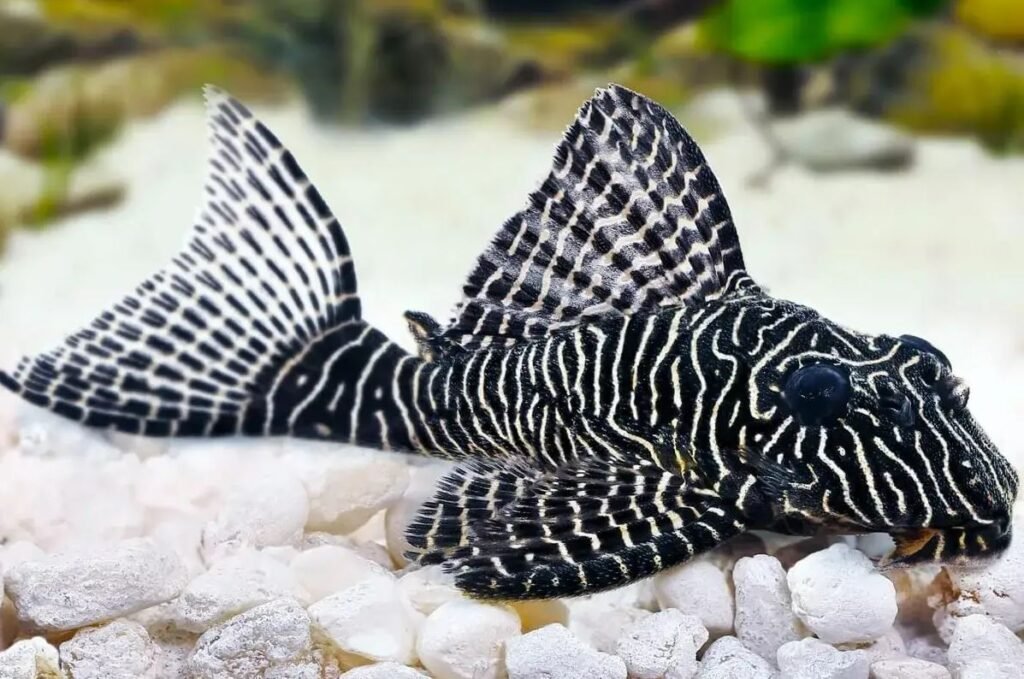
The queen arabesque pleco is a small, exotic fish that grows to just around 3.5 inches under good care. Like many other plecos in this list, this pleco likes a good deal of driftwood in its tank; it also loves to have its own cave. They have a carnivorous tendency in their diet and love to eat live food. They’re best matched with a planted environment with a moderately strong current. They are sensitive to nitrogen and low oxygen levels in the water. They take some time to adapt to a new aquarium and can get pretty shy.
Pitbull Pleco – Parotocinclus jumbo

This fish reaches about 2.5′′ at maturity and is usually a slow grower. Pitbull plecos are social and should go in groups of at least three, but if you have the necessary space, go with six or more (a 30-gallon tank is recommended for six of them). They are ravenous algae-eaters and love algae wafers. Anything with animal protein should be given very occasionally (a few times a month). They are clumsy and can break plants during feeding.
All in all, the Pleco is a great addition to your aquarium
Why is the pleco a great fish for your aquarium?
Plecos are hardy fish. They can withstand the most extreme water conditions. This makes them very easy to maintain, giving you basic filtration and some algae in return. You even do not have to know exactly how many are there in your tank. Just add food regularly and keep an eye on nitrates and the quality of the water.
Plecos are the best fish for algae eating.
They eat almost any algae in your tank; they’re not picky about food and will eat some algae that other fish will refuse, such as green spot algae.
You can keep more than several plecos in a community aquarium, but be careful with larger and more aggressive species such as the common pleco; they can grow enormous and may eat smaller fish if they are hungry enough. Only get large ones if you plan on keeping them alone or breeding them. Make sure to give a fish the space it will need as an adult at full size.
If you have a problem with algae and can’t find an effective fish to help solve it, then add an algae-eating pleco or two to your aquarium and start enjoying clear water again!
Pleco’s are also great scavenger fish
They love leftovers as much as live food, so make sure you feed them some extra food after you have fed your other fish.
If you want more than one pleco, consider buying a group of 3-4 newborns rather than just buying one adult. Some plecos are known to attack and kill their own kind if hungry enough (massive ones). It’s all about being prepared!
If you are keeping these fish, then always give them plenty of places to hide, such as rock caves, driftwood, and plants. This will make them feel much happier as they are nocturnal fish and sleep during the day. And make sure to have enough algae and biofilm for all the fish.
Give them places to hide
If you do not give them places to hide then they may attack your other fish/shrimp & snails, or even bite off their own fins out of stress – especially newly purchased ones who are still stressed from moving into a new aquarium. Always prepare your fish before adding them to your tank by placing them in a plastic bag inside the main aquarium for 15-30 minutes (depending on size), so they get used to the temperature first. Be careful not to add too many at once! This can destabilize the filtration, which leads to ammonia spikes.
They like deep substrates such as river gravel, sand, or clay balls, but it is not required as they will live quite happily in the normal aquarium gravel. Just make sure that the substrate doesn’t have any sharp points that would hurt the plecos’ mouths. Keep in mind that a deep substrate makes cleaning more difficult. Siphoning the bottom of the tank is necessary several times a week to keep it free of residues.
Try not to change the substrate you are using too frequently, as this may stress them out. If you want a different substrate, then prepare their tank by doing a large water change (50%+) before adding the new substrate, and slowly fill the tank up over a couple of days.
The bottom line is, never ever consider your pleco just another “algae eater”
Plecos are an integral part of your aquarium. You should care for them as pets and admire their beauty. Appreciate what they do for you and your other fish because without them, many tanks would be overrun with algae!
For more info, you can check out
Our link to our pleco care article is here.
Wrapping Up
Plecos are amazing fish that come in a variety of shapes and colors to suit every water tank. You can find the perfect pleco for your aquarium with this list, so go out and grab one or two today! We hope you found this blog post helpful; if there’s anything else we can do for you, please don’t hesitate to reach out.


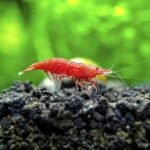

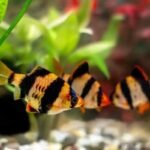

![Latest Top 15 Best Fish Tanks in 2022[Buying Guide] Latest Top 15 Best Fish Tanks in 2022[Buying Guide]](https://aquariumhunter.com/wp-content/uploads/2020/07/51QBCSti2GL._SL300_.jpg)
![[Latest 2023] Top 7 Best HOB Protein Skimmer For Saltwater Marine, Reef Tanks [Latest 2023] Top 7 Best HOB Protein Skimmer For Saltwater Marine, Reef Tanks](https://aquariumhunter.com/wp-content/uploads/2021/04/Best-HOB-Protein-Skimmer.jpg)